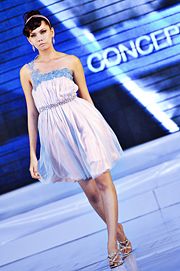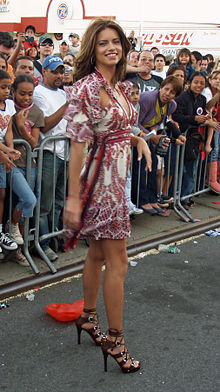Model (person)
A model is a person who is posed or displayed for the purpose of art, fashion, or other products and advertising.

Modeling is distinguished from other types of public performance, such as an acting, dancing or mime artistry, although the boundary is not well defined. Appearing in a movie or a play is generally not considered to be modeling, regardless of the nature of the role. However, models generally have to express emotion in their photographs, and many models have also described themselves as actors.
Types of models include glamour, fashion, fitness, bikini, fine-art, and body-part models.
Not all models are beautiful: character models portray ordinary people and humorous types, mostly in print work and in commercials. Photo manipulation and cosmetic surgery also enable people with body imperfections to model and change their looks to suit a certain role.
Various representations of beauty and fashion using models have caused controversy and is known to have some social impact, particularly on young people - both male and female.
Male models receive overall less publicity and are often paid less than female models. Nevertheless, some companies, like Calvin Klein are known for producing successful male models.
The most famous female models (also known as supermodels) include Tyra Banks, Cindy Crawford, Christie Brinkley, Naomi Campbell and Elle McPherson.[1]. Fabio Lanzoni, known for his powerful physique and long hair is widely regarded as the most famous male model, while Antonio Sabàto, Jr. is another well known male model.
Contents |
Fashion

Fashion models are used mainly to promote apparel. Fashion Modeling generally can be divided into two categories (editorial and runway), and into the following sub-categories:
- Ad campaigns
- Fashion catalogue modeling
- Fashion catwalk or runway modeling
- Fashion editorial (magazine spreads etc.) modeling
- Fashion print modeling
- Fashion lingerie modeling
- Fashion showroom modeling
- Fashion swimsuit modeling
- Fashion fit modeling
- Fashion fitness modeling
- Petite modeling
- Plus-size modeling
The first fashion model was believed to be Parisian shopgirl, Marie Vernet Worth. She became the first professional mannequin in 1853, to help her fashion designer husband, Charles Frederick Worth.[2]
Body type

Body type and image is central to most types of modelling.
Female
The Association of Model Agents (AMA) says that female models should be around 34-24-34 in (86-60-86 cm) and at least 5 ft 8 in (1.73 m) tall. Currently, the height required to do fashion shows has increased. During the last fashion shows in Europe, the average height was 1.79 m (5 ft 10 in), the average weight was 50 kg (110 lb), with bust between 85 to 90 cm (33 to 35 in), waist under 62 cm (24 in), and hips under 90 cm (35 in), to fit the 34/36 size of haute couture prototypes.[3] Average dimensions for a male model are a height of 1.80 to 1.88 (5 ft 11 in to 6 ft 2 in) a weight of 64–75 kg (140–170 lb) and a chest measurement of 37–42 in (93.98–106.68 cm).
The ideal measurements used to be 90-60-90 cm (35-24-35 in) which allegedly referred to the measurements of Marilyn Monroe. However, today's fashion models tend to have the measurements of the AMA which could be down to the coherence of the numbers 34-24-34 in (86-61-86 cm).
The unusually thin shape of fashion models has been criticized for allegedly warping girls' body image and encouraging eating disorders.[4] Organizers of a fashion show in Madrid in September 2006 turned away models who were judged to be underweight by medical personnel who were on hand.[5] In February 2007, six months after her sister, Luisel Ramos - also a model - died, Uruguayan model Eliana Ramos became the third international model to die of malnutrition in six months. The second victim was Ana Carolina Reston.[6] Luisel Ramos died of heart failure caused by anorexia nervosa just after stepping off the catwalk.
Male
Male models are typically muscular, either lean or bulky (sometimes bodybuilders) and often suave. These physiques can be achieved artificially through the use of drugs, such as anabolic steroids and unlike sports, the fashion industry is not regulated in terms of the use of these drugs.
The portrayal of male body image by models is known to have a psychological impact particularly on young, still developing men and is believed to have contributed to an increase in teenage depression, steroid abuse and associated health problems.[7]
Glamour models

Glamour photography emphasizes the model rather than products, fashion or environment. Typically the sexuality of the model is emphasized in glamour photography, while in fashion photography the emphasis is on the clothes.
Early glamour modeling is often associated with "French postcards", small postcard sized images that were sold by street vendors in France. In the early 1900s the pinup became popular. Pinups depicted scantily dressed women often in a playful pose seemingly surprised or startled by the viewer. The model would usually have an expression of delight which seemed to invite the viewer to come and play. Betty Grable was one of the most famous pinup models of all time; her pinup in a bathing suit was extremely popular amongst World War II soldiers. In December of 1953 Marilyn Monroe was featured in the first issue of Playboy magazine. Playboy became the first magazine featuring nude glamour photography targeted to the mainstream consumer. Glamour models popular in the early 90s included Hope Talmons and Dita Von Teese and the modern era is represented by models like Heidi Van Horne and Bernie Dexter.
Supermodels
Supermodels are highly paid, top fashion models. These (usually female) celebrities, also known as cover girls, appear on top fashion magazine covers, in catalogues and in fashion shows. The first model to pave the way for what would become the supermodel was Lisa Fonssagrives.[8] The relationship between her image on over 200 Vogue covers and her name recognition led to the importance of Vogue in shaping future supermodels. Her image appeared on the cover of every fashion magazine during the 1930s, 1940s and 1950s from Town & Country, Life and Vogue to the original Vanity Fair. Model Janice Dickinson has asserted that she was the person for whom the term was coined, as she popped the term herself while talking to her agent at the climax of her career by saying, "I'm not superman, I'm a supermodel".
Fitness models
Fitness modeling centers on displaying an athletic and healthy physique. Fitness models resemble bodybuilders, but with less emphasis on muscle size. Their body weight is usually similar to (or slightly heavier than) fashion models, but they have a lower body fat percentage due to increased muscle mass relative to fat mass. They are usually muscular. The most recognized, by name, fitness models are Sebastian Siegel and Michael O'Hearn.
Bikini models
Bikini models are similar to fitness models with emphasis on a fit physique and the beauty of the female curves. Bikini models are usually curvaceous and fit.
For women, usually the models can be shorter, around 5 ft 5 in-5 ft 8 in (1.65 m-1.73 m) and need to be in the range of 90–110 lb (41–50 kg).
Fine art models
Photographers, painters, sculptors, and other artists hire models to pose for their art.
Alternative models
An alternative model is any model that does not fit into the normal category. Punk, Goth, Fetish, Tattooed, or having a uniqueness outside other model types. These mix with high fashion and art models. Thanks to publishers such as Goliath in Germany, alternative models and punk photography became known by a larger audience.
Body part models
Some modeling agencies have divisions which represent male and female models with particularly attractive body parts. For example, hand models may be used to promote nail care products, leg models are useful for showcasing tights, and wrist models are used to showcase watches or bracelets. Petite models or females who are under 5 ft 7 in (1.70 m) have found success through body part modeling. An example of a petite body part model is Isobella Jade.
Working conditions
Despite the stereotype of modeling as a lucrative and glamorous profession, according to the US Bureau of Labor Statistics the median wage for models was only $11.22 per hour in 2006.[9] MarketWatch listed modeling as one of the worst ten jobs in America.[9]
See also
- Time for print
- Child modeling
- Figure drawing
- Hip hop model
- List of black fashion models
- Modeling site
- Promotional model
- Spokesmodel
References
- ↑ http://www.fashionologie.com/fashionologie/2006/12/the_super_super.html
- ↑ history from modelworker
- ↑ Presque Top Model Oct 06
- ↑ USA Today: Do thin models warp girls' body image?
- ↑ CNN: Skinny models banned from catwalk
- ↑ Ban on stick-think models illegal, Jennifer Melocco, The Daily Telegraph, February 16, 2007.
- ↑ Male models intimidate young men from the Telegraph, 2001
- ↑ Rosemary Ranck, "The First Supermodel", The New York Times February 9, 1997 (online) retrieved September 24, 2006
- ↑ 9.0 9.1 Mantell, Ruth (November 1, 2007). "The 10 worst jobs in America: Low pay, no benefits put these workers in a tough spot", MarketWatch, Dow Jones. Retrieved on 2008-01-31.
